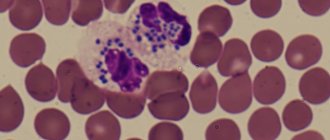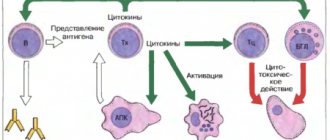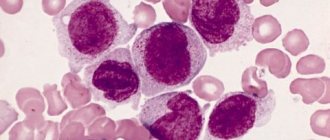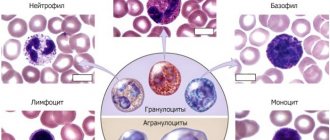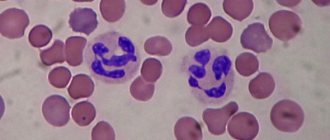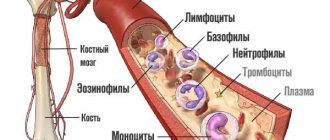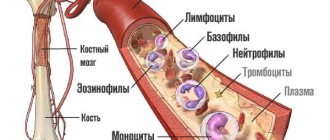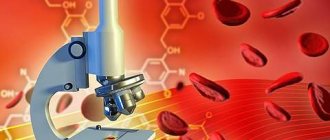Increased levels of neutrophils (neutrophilia)
Phagocyte engulfs bacteria
The main function of neutrophils is to protect the body from all kinds of pathogenic particles. They instantly react to the penetration of a foreign microorganism, absorb it and digest it. The neutrophils themselves then die, releasing a large amount of specific substances that destroy the remaining bacteria.
Neutrophils are the most numerous group of leukocytes; their levels are usually determined during a standard clinical blood test. If the values exceed the norm, an inflammatory process occurs in the body. This condition is called neutrophilia. Depending on the degree of increase, you can determine how extensive the inflammation is.
The study of the number of neutrophil cells involves measuring their total number in a unit of blood, as well as their percentage of the total number of white blood cells.
Values above normal for adults:
- in absolute quantity - > 6.5 * 109/l;
- as a percentage - > 75%.
Norm
The norm of neutrophils in children differs from that in adults. The indicator is indicated as a percentage and is not tied to gender, but changes only with the age of the child. The study necessarily determines the segmented and band content of neutrophils. Each age group has its own norm.
For example, the norm of band neutrophils for a newborn is 5-12%, after 5 days and up to 5 years of age the norm is from 1 to 5%, and over 5 years the normal index is within 1-4%. As for segmental neutrophils, the absolute number is:
- newborns have rates in the range of 50-70%;
- on the 5th day after birth, the rates decrease to 35-55%;
- in 1 month from the moment of birth the norm is 17-30%;
- a one-year-old child has a norm of 20-35%;
- five-year-old child - 35-55%;
- child 10 years old and older - 40-60%.
Important information: What does it mean to have low lymphocytes in the blood of an adult (reasons for the decrease)
A normal number of particles protects the child’s body from various types of infections, because are mobile particles and when an inflammatory focus occurs they are directed towards it.
Causes of neutrophilia in adults
Neutrophilia is a faithful companion of bacterial infection
The growth of immune cells indicates the body's response to pathogens. Detection of an increased value of neutrophils indicates the following reasons:
- diseases caused by bacteria: pneumonia, tonsillitis, otitis media, sinusitis, dysentery, tuberculosis, diphtheria, lymphoreticulosis, osteomyelitis, tetanus, syphilis, gonorrhea and others;
- tissue necrosis resulting from gangrene, extensive burns, cardiovascular diseases;
- fungal diseases: mycosis, candidiasis, lichen;
- oncological diseases of various organs;
- diabetes;
- inflammatory lesions of the skin;
- anemia;
- pathologies of the circulatory system;
- intoxication, including alcoholic beverages.
Segmented neutrophils are increased in adults
Neutrophil development
Neutrophils originate in the bone marrow and go through developmental stages from myeloblast to band cell and then segmented cell. Mature cells contain a nucleus, which consists of segments interconnected by nucleoprotein threads. In the bloodstream of an adult, they make up about 70% of all leukocytes.
Segmented neutrophils live for about 14 days, after which they are destroyed in the liver and spleen. If cells encounter pathogenic particles, they die earlier in the fight against them. Accelerated cell death provokes the active generation of new neutrophils. This process continues until the tissues damaged by microbes are completely restored. Therefore, an increased amount indicates an inflammatory process in the body or its presence in the recent past.
Having detected increased values of segmented neutrophils, the doctor will prescribe additional examinations to determine the cause. Factors that cause the growth of mature cells can be inflammatory phenomena, infectious processes, malignant tumors, diseases of the cardiovascular and respiratory systems.
The indicator is higher than the norm for adults - > 72%.
What level is considered elevated?
If neutrophils in a child’s blood are elevated, this indicates an inflammatory process. A slight increase in these cells in the blood may be temporary, and simple experiences or excessive activity in children can cause this phenomenon. In such cases, other indicators remain normal.
When the tests are repeated, an increase in neutrophils and other leukocytes may be detected, then additional, more thorough studies are prescribed, because an increase in indicators may indicate a disease and require immediate treatment. If segmented neutrophils are elevated in a child, this indicates the presence of some kind of disease, since this type of neutrophil is responsible for immunity.
What does the increase mean?
An increase in segmented neutrophils directly indicates the presence of a progressive virus in the child’s body. It could be a purulent abscess, pneumonia, infection, or blood cancer. Elevated levels in a child’s blood may mean that he has neutrophilia, which means the presence of granulocytes exceeds leukocytes. Neutrophilia in a child is characteristic of leukocytosis of the newborn, pathological leukocytosis caused by infection or inflammation.
Neutrophilia can be caused by teething in infants because... This period is considered an inflammatory process in the body, and the immune system works more actively.
There are 2 types of neutrophilia: absolute and relative. Absolute occurs when the number of neutrophils increases by 1 unit of blood volume. When the percentage of neutrophils in the blood increases, relative neutrophilia is determined.
Neutrophilia plays an important role in the treatment of infectious diseases, because. In almost all cases, segmented neutrophils are increased. Doctors use analysis to identify neutrophilia in a child, the causes of which can be not only the presence of the disease, but also severe fatigue. This is especially true for children of primary school age who are just beginning to get used to changes in life. May be associated with nervous tension due to problems in the family (divorce, death of a loved one).
Important information: What do low monocytes in an adult indicate (monocytopenia in women)
Band neutrophils are elevated in adults
Band neutrophils in a blood smear
An immature neutrophil has a nucleus that resembles a rod in appearance, hence its name. Band cells undergo maturation in the bone marrow, so their number in the bloodstream of an adult is small. On average, they make up 3 to 5% of all types of immune cells.
Unlike segmented cells, immature cells do not have all the tools to fight harmful microorganisms. Their main task is to develop to the next, mature level. An increase in their number per unit of blood means that new neutrophils are being actively produced.
An increase in units of immature cells is called a shift in the leukocyte formula to the left. This is a characteristic indicator that in most cases means a deterioration in the patient’s condition. For example, if an increase in band neutrophils is detected against the background of influenza, we are talking about the addition of a bacterial infection.
Therefore, diagnosis of band cells is mandatory during therapy, the postoperative period, and termination of a course of medications. An elevated reading will indicate a complication.
The value is higher than the norm for adults - > 6%.
How to detect neutrophilia?
The basis for diagnosing neutrophilia is a clinical blood test
The level of neutrophils is diagnosed based on a detailed clinical blood test. Before analyzing the level of neutrophils, it is necessary to refuse food 8 hours before blood collection, exclude physical overexertion, alcoholic beverages and medications.
Values above normal indicate the presence of neutrophilia. This pathology is divided into 3 stages, depending on the level of excess of the norm.
- The absolute number of neutrophils is up to 10 * 109/l - inflammation of a moderate nature, localized in one focus;
- The number of cells is diagnosed from 10 to 20 * 109/l - pronounced neutrophilia with a more severe inflammatory process that has spread beyond one focus;
- The level of neutrophils in a unit of blood is determined from 20 to 60 * 109/l - a severe stage, indicating extensive damage to the body as a whole.
If the form with the analysis results indicates only a percentage, you can calculate the absolute indicator using the formula:
Relative indicator * number of leukocytes / 100.
If the percentage is 68, and there are only 7 * 109/l leukocytes, then 68 * 7 / 100 = 4.76.
How to determine excess
You can determine that neutrophils are elevated by the presence of a number of symptoms and a blood test. Analysis allows us to determine the absolute value of this element. If the examination indicators are too high, blood is taken again to clarify the diagnosis. In some cases, the ratio of cells of different ages is calculated:
- Segmented cells are mature cells that are most effective and are one of the main elements of the immune system.
- Bands - include all immature neutrophils, which are used only in case of a shortage of segmented ones.
Bands include:
- myeloblast;
- promyelocyte;
- myelocyte;
- metamyelocyte.
Symptoms
The following symptoms indicate that neutrophils are elevated in the blood:
- headache;
- elevated temperature;
- increased sweating;
- bruises on the skin;
- pain in the gastrointestinal tract;
- chronic nausea.
Important information: What do elevated band or segmented neutrophils indicate in a blood test during pregnancy?
The protective cells themselves appear as pus on the inflamed area. This is explained by their function - phagocytosis. To destroy hostile microorganisms, the neutrophil uses its own enzymes, which soften the tissue at the site of absorption. This manifests itself in the form of a purulent abscess.
Analyzes and their interpretation
A general blood test will help determine whether neutrophils are low or high in the blood. The results indicate the percentage of neutrophils from the total number of white blood cells. This type of blood cell is referred to by abbreviations such as NEUT or NE. Their number depends not only on age-related development, but also on the physical and psychological health of a person.
The blood test results contain a value that reflects the content of this element in one unit of blood (value multiplied by 109). The phenomenon in which neutrophils are higher than normal is called neutrophilia. However, an increase in neutrophils does not always pose a threat to the patient’s life. Depending on the number of protective cells, the following degrees of deviation are distinguished:
| Neutrophil count (×109) | Stages of Deviation |
| 7-9 | insignificant |
| 10-20 | acute |
| more than 21 | heavy |
To determine whether ABS neutrophils are increased or decreased, it is necessary to multiply the percentage of neutrophils by the number of lymphocytes, and then divide the resulting value by 100.
There is a possibility of obtaining false test results. This happens in cases where patients violate the rules for preparing for this type of analysis. In order for the results to be reliable, before the procedure it is prohibited:
- intense physical activity for several days;
- food intake (the last time you are allowed to eat is 6-8 hours before the examination);
- drinking energy drinks, coffee or strong tea in the morning.
Smoking and alcohol especially increase the number of neutrophils, so it is recommended to avoid them 2-3 days before the test.
What could affect the results of the study?
Eating the day before the test can trigger neutrophilia
Moderate neutrophilia indicates not only pathogenic processes, but also reflects some physiological conditions. Small cell growth can be caused by:
- pregnancy,
- increased physical activity,
- stress,
- large meals.
A number of drugs also cause an increase in the number of neutrophils. If taking medications cannot be stopped before taking the test, you must inform your doctor about this.
Medicines that increase neutrophil levels:
- Acetylcholine chloride,
- Chlorpropamide,
- Heparin,
- Histamine,
- Norepinephrine,
- all corticosteroid medications,
How to treat deviation
To begin treatment, it is necessary to make an accurate diagnosis. The cause of the deviation may be temporary and go away on its own (allergies to medications and food, surgery, vaccinations). A temporary increase is most often an effect on the treatment of another disease.
If the cause of elevated indicators is any disease, then to stabilize the level of the protective element it is necessary to cure the underlying disease.
It is not recommended to engage in self-treatment using medications, homeopathy or various folk remedies. The restoration of cell number will be positively affected by:
- quitting smoking and alcohol;
- seasonal intake of vitamins;
- good nutrition;
- distribution of physical activity;
- reduction of stressful situations.
Important information: What do elevated white blood cells mean in a child’s blood test?
How to lower neutrophil levels in adults?
The cause of neutrophilia must be determined by a specialist
If the number of neutrophils has increased, then the immune system needs this number of cells to suppress pathological processes in the body. Therefore, there is no need to specifically reduce the level of neutrophils. It is necessary to find the reason for their increase, eliminate it, then the number of immune cells will return to normal.
The most common factor in the growth of neutrophils is bacterial infection. Depending on the disease, the patient will be prescribed a course of narrow or broad spectrum antibiotics. To treat fungal infections, various antifungal agents are used, and if they recur, antibiotics are used.
Reference values of the indicator by age
Depending on the age of the child, segmented leukocytes are present in the blood in greater or lesser quantities. An excessive amount of them is called neutrophilia, and a low amount is called neutropenia.
Normal blood levels are presented in the table:
| Age | Norm |
| newborns up to 5 days | 70% |
| in infants from 5 days to 1 month | 55% |
| from 1 month to 1 year | 30% |
| from one year to 5 years | 35% |
| from 5 years to 10 years | 55% |
| over 10 years old | 60% |
An increase in neutrophils in a child’s blood is an alarming sign that cannot be ignored, as this could lead to serious infectious diseases being missed.
It is especially important to conduct a full examination if the level of leukocytes is elevated in a child under 3 years of age, since at this age the child cannot yet correctly describe the symptoms and accurately characterize his condition, which makes it difficult to timely and accurately identify the pathology.
The danger of increased levels of neutrophils in the blood
Neutrophilia without attention is fraught with complications
An increase in the number of neutrophils is not always accompanied by severe symptoms. A person can consider himself absolutely healthy, but detect a deviation from the norm only on a form with test results. This may mean that there is a hidden infection in the body. If no action is taken, the inflammatory process will spread to larger areas.
Malignant and benign tumors are manifested by increased levels of neutrophils. If over a long period the number of cells significantly exceeds the norm, the doctor may suspect the oncological nature of the pathology in the patient.
During pregnancy, a small increase in neutrophils is considered normal. But too high values can lead to miscarriage, since neutrophils perceive the fetus as a foreign organism in the woman’s body.
Why is the level increasing?
Reasons that cause an excess in the number of neutrophil cells:
- strong physical activity;
- digestion of heavy food;
- taking certain medications;
- stress.
But most often, if neutrophils are elevated in an adult, this indicates a disease. The entry of a foreign microorganism serves as a signal, and leukocytes begin to actively multiply. Many segmented cells indicate the following diseases:
- disturbances in the urinary system;
- spirochetosis;
- various leg tumors;
- inflammatory processes (with arthritis, pancreatitis, rheumatism or gout);
- leg diseases;
- tick-borne encephalitis.
Important information: What are platelets according to Fonio (normal)
Some diseases increase the number of band neutrophils:
- burns;
- diabetes;
- otitis;
- gout;
- nephritis;
- malignant and benign tumors;
- surgical operations;
- high and low temperatures;
- allergies to medications;
- injuries.
An increase in neutrophils in a child’s blood can be provoked by:
- food allergies, especially to lactose;
- vaccination;
- teething;
- helminthic infestations;
- polyps in the nasal cavity;
- acute intestinal diseases;
- chronic adenoids and tonsillitis.
The most common causes of neutrophilia are the following diseases:
- nephropathy;
- mycosis;
- pneumonia;
- rheumatism;
- dermatitis.
Among women
If there is an increased content of neutrophils in the circulatory system, a pregnant woman should urgently consult a doctor, as this can have dangerous consequences not only for the woman, but also for the fetus. If neutrophils in the blood are increased by more than 40-60×10⁹, this can cause miscarriage or premature birth. Therefore, future mothers should definitely be observed by specialists. In the first trimester, there is a slight increase in neutrophils, but later their number levels off.
During menstruation, the number of neutrophils in the blood of women decreases greatly and sharply. Also, the results of the study may be affected by various medications taken during menstruation. It is recommended to carry out the analysis during the menstrual break (you can start from the 7th day after the end of menstruation).
In men
There is no difference between neutrophil levels in men and women. This means that, in addition to the pathologies listed above, an increased level of neutrophils can only be caused by sexually transmitted diseases. The list of such diseases includes:
- chronic and acute urethritis;
- epididymitis;
- balanoposthitis;
- orchitis;
- prostatitis.
Prevention
Prevention of neutrophilia is the key to good health
In order for neutrophils not to have to intensively fight pathogenic bacteria, it is necessary to help the body avoid the penetration of pathogenic microbes.
- Berries, fruits and vegetables should only be consumed clean. Meat, fish, milk must be thermally processed correctly.
- It is necessary to maintain personal hygiene: thoroughly wash your hands, brush your teeth, and keep household items clean.
- The living space must be ventilated daily and wet cleaning must be carried out regularly.
- It is necessary to avoid contact with sick people.
- Wounds and abrasions should be disinfected and protected from the external environment with a bandage or plaster.
